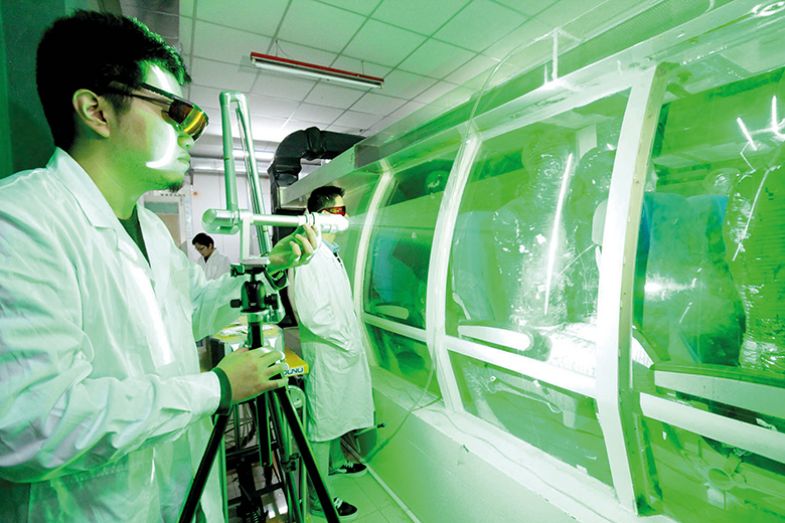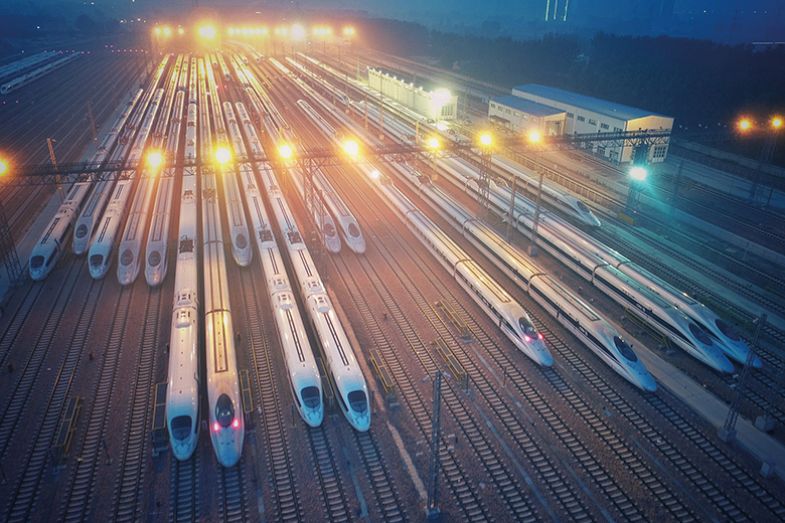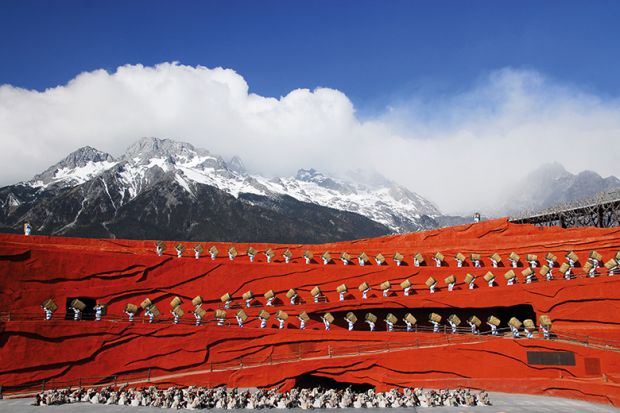Browse the full THE Asia-Pacific University Rankings 2019 results
A couple of centuries ago, China boasted the world’s biggest economy. Literacy was nurtured through a flourishing publishing industry and knowledge dissemination through vast encyclopedias and dictionaries.
As the new millennium gathers steam, the world’s biggest country is reasserting its place at the top of the global pecking order. It will reclaim the mantle of the world’s biggest economy by the end of the next decade, according to some estimates, with others suggesting it has done so already. It has eclipsed Europe in research and development spending and is on track to surpass the US. Its share of global scientific publications exceeds its share of global gross domestic product, leading the world in raw volume and close to overtaking the US in terms of impact.
With such momentum, it was only a matter of time before China started topping university league tables. Few will be surprised to find Tsinghua University occupying first place in this year’s Times Higher Education Asia-Pacific University Rankings, after the Beijing institution edged past the National University of Singapore to become Asian front-runner in the 2019 World University Rankings.
Tsinghua – ironically located on the site of the gardens of the Qing Dynasty, China’s last imperial leaders, who constructed the fifth biggest empire in history – stormed up the World University Rankings ladder from 71st in 2012 to 22nd this year.
Since the APAC rankings debuted in 2017, Tsinghua has maintained or improved its score each year in all five pillars underpinning the tables: teaching, research, citations, international outlook and industry income. It is the star performer in a nation that is rapidly improving its ranking performance, both in quantity and quality.
View this year’s Asia-Pacific University Rankings methodology in full
While the number of ranked institutions in the region has grown by almost a third in two years, from 243 in 2017 to 320 this year, China has nevertheless managed to increase its share of entries from 21 per cent to 23 per cent during the same period. And of the 60 Chinese universities that were also ranked last year, 40 per cent have improved their standing.
This compares with 30 per cent in South Korea, 17 per cent in Taiwan, 10 per cent in Japan and none in Thailand.
More than a competitor, China is the comparator by which neighbours evaluate their own performance. “Even staying still in the rankings is not unreasonable these days” given China’s strength, says Nicholas Fisk, deputy vice-chancellor at the University of New South Wales.
Hamish Coates, a professor at Tsinghua’s Institute of Education, says that China owes its rankings success to more than the much-vaunted government investment in universities. “Pretty much since the massification of Chinese higher education in 1998, there’s been an emphasis on science and technology,” he says.
Download a copy of the Asia-Pacific University Rankings 2019 digital supplement
“About half of the faculty and students are studying in those kinds of fields. And those kinds of fields tend to get reflected very well in the current international rankings. The rankings measure what they measure, and they happen to be in the space in which China has always been very much focused.”
But the rankings do not necessarily reflect the full reach or complexity of the Chinese diaspora. Coates says that researchers within the country, combined with Chinese students and academics located abroad, are responsible for about 50 per cent of global science.
“That’s our best guess,” he says. “Over the past 20 years in which China has sent tens of thousands of students around the world to study PhDs, the world has not sent tens of thousands of students to study in China. The international literacy of Chinese PhDs far exceeds the international literacy of almost any other country.
“That has led to a situation where Chinese students can read English, often fluently, but not many other students can read Chinese research. There are narratives built [by Westerners] around Chinese research that bear little resemblance to the research [Chinese academics are] talking about. Higher education is replete with that kind of practice.”
The rankings also underestimate China’s linguistic reach, Coates says. “Most people here publish as much in Chinese as they do in English. They’re not the same publications – they’re different pieces of work, often reflecting different projects and done for completely different reasons. None of that Chinese publication by and large gets picked up in the Western metrics.”
He says that the metrics also struggle to reflect the contributions universities are making to distinct fields and regions through China’s Double World-Class initiative, the planet’s biggest university investment programme, whose goal is to catapult 42 institutions into the global front rank by 2050.

Zhejiang University, another Chinese success story, credits the scheme for the country’s rankings progress. “Based on the Double World-Class initiative, many Chinese universities have taken measures to encourage innovation and improve quality and reputation,” says He Lianzhen, Zhejiang’s vice-president of international affairs.
“With China’s economic growth and favourable policies for the development of higher education…I look forward to continuous improvement in the performance of Chinese universities.”
Zhejiang is knocking on the door of the world top 100, having soared from the 301-350 bracket in the 2012 World University Rankings to 101st this year. In the APAC rankings, the university has risen from 29th in 2017 to joint 19th this year, leapfrogging two Chinese counterparts in the past year to become the country’s fourth-best performer.
The APAC rankings methodology differs slightly from that of the World University Rankings, with less emphasis on teaching and research reputation and more on industry income, research income and research productivity – another factor that could favour institutions in China, where many major enterprises are state-owned. But He says that collaborations with government-owned enterprises contribute to only a “portion” of Zhejiang’s industrial revenue.
She says that R&D collaborations with private sector companies also attract considerable earnings, given the university’s “advantageous location” in Hangzhou (pictured below) – the “hub of the new economy” in China.
As well as industry income, Zhejiang has registered marked improvements in its teaching and internationalisation. Zhejiang’s He says that the two are linked, with internationalisation considered a “driver” of student experience.
“The university has witnessed a substantial increase in the numbers of foreign students and faculty over the past year,” she says. “Chinese students benefit from engaging with them.”
Australia’s Fisk says that China’s approach to university funding is the scientific equivalent of its One Belt, One Road initiative.
“They’re really on a roll,” he says. “Their unmoderated GDP is still rising significantly. You’ve got reverse brain drain. You’ve got high investment. And you’ve got some really good elite institutions.”
China’s metrics are also boosted by a burgeoning penchant for self-reference, he says. A recent Nature analysis found that 47 per cent of citations in papers authored by academics in China referred to other Chinese papers, putting the East Asian giant 10 percentage points ahead of a traditionally inward-looking US in terms of “country self-citations”.
“Chinese colleagues who used to come abroad didn’t want to go home. Now they can’t wait to get back to all their sophisticated electronics,” Fisk says, adding that China boasts great airlines, slick hotels and the most extensive bullet train network in the world.
Despite all this, China remains hampered by an emphasis on quantity over quality – it still trails the US and Europe in highly cited papers – and by the “skeleton in the closet of bureaucracy and government intervention”, Fisk says. “When we [in Australia] recruit people, academic freedom is one of the competitive advantages.”
The rankings decline of long-time Chinese front-runner Peking University has coincided with political meddling in its leadership. In October, former president Lin Jianhua was suddenly replaced by Hao Ping, a one-time Chinese vice-minister of education who had also served as Communist Party secretary of the institution.
Peking ranks sixth in this year’s APAC rankings – down from third last year and second in 2017 – although its descent largely reflects a fall in its industry income.
But to appreciate the contribution of academic autonomy to university rankings, China’s leaders need only look at its special administrative region of Hong Kong. Of six ranked institutions in the territory, two have moved upwards and two are stable in this year’s table.
The climbers include Hong Kong University of Science and Technology, which leapfrogged Peking and cross-town rival the University of Hong Kong to claim fourth place behind Tsinghua, the NUS and the University of Melbourne.
While commentators worry that Beijing’s increasingly assertive stance could reach across the border, HKUST president Wei Shyy says that Hong Kong’s government and University Grants Committee are “very mindful” of the importance of maintaining academic autonomy.
“I don’t see that changing,” he says. “Hong Kong is trying to figure out its way forward in many aspects – socially, economically, politically – but within our campus, we don’t have any interference. I can say that categorically. Nobody ever calls me to tell me what we can and cannot do in terms of academic conduct.”
HKUST’s programmes are taught almost entirely in English, Shyy points out. “Many students don’t have a Chinese background,” he says. “Fundamentally, we want to make sure that all students feel this is a place for them to learn.”
But he says that as a predominantly Chinese society, Hong Kong does not lack opportunities for immersion in Chinese culture, knowledge and insight. “It’s just that we would like to use English on campus for professional activities, and this also will help our local students advance their communication skills in English. That’s quite important.”
While the University of Hong Kong trumped HKUST in this year’s World University Rankings, HKUST prevailed in the APAC rankings on the strength of superior industry income. But Shyy says that as a much younger institution – HKUST was established in 1991, 80 years after the University of Hong Kong – it also benefits from being “a little more agile”.
He adds that HKUST has not modulated its activities to maximise rankings performance. “The ranking frameworks match quite well in terms of where we have been going anyway,” he insists.
Nevertheless, HKU’s vice-president for teaching and learning, Ian Holliday, says that the league tables drive plenty of “friendly competition” between the territory’s universities.
“All of us have been chasing rankings, frankly,” Holliday says. “We’re all conscious of the rise of the university sector in the mainland and other parts of the region. All of us feel that unless we’ve got a respectable ranking – and respectable means different things, depending on who you are – then we’re not going to thrive in attracting international talent – both colleagues and students.”

While China’s rise is largely at the expense of neighbouring university systems, plenty of individual institutions have nevertheless found ways to get ahead. The pacemaking institutions in almost all the region’s countries have moved up this year’s APAC rankings.
Melbourne, HKUST, Japan’s Tokyo and Kyoto universities, South Korea’s Seoul National and Sungkyunkwan universities, the National Taiwan University, Malaysia’s University of Malaya, the University of Macau, the University of the Philippines and the University of Indonesia all notched up improvements.
How have these national stars resisted the Chinese tide? In Japan’s case, Double World-Class-style flagship programmes – most recently, the Designated National University initiative – have helped to buoy the leading institutions.
The University of Indonesia, which aspires to be among the world’s best institutions, has set its sights on being an Asian front-runner as an intermediate goal. “It’s there in one of the world’s biggest countries, funnelling money and energy into its pre-eminent higher education institution,” Coates says. “How that will play out, we don’t know.”
South Korea’s top players are reaping the benefits of high R&D spending from both government and industry in areas such as biotechnology, and a global fascination with Korean youth culture that has helped to attract foreign students.
Of the nine Malaysian institutions ranked in both 2018 and 2019, five – including the top two – have moved up the APAC ladder. Zaharom Nain, a communication studies professor at the University of Nottingham’s Malaysia campus, says that the improvement of the country’s institutions largely reflects progress in the sciences and engineering, which are areas of national strength.
While Malaysian academics breathlessly anticipate reform in the wake of the ousting of the repressive government of Najib Raza, Zaharom says that enhanced autonomy might not translate to enhanced rankings performance. He notes that there has never been much state meddling in engineering or the sciences, outside a few flashpoint issues such as climate change and palm oil.
“Freedom of speech or expression – these ideas are very much related to the social sciences and humanities,” he says.
Australia, like China, has seen 40 per cent of its institutions improve their standing in this year’s APAC rankings. Fisk says that the two countries perform very similarly in the major global league tables, with roughly the same number of top 200 institutions and almost identical average placings.
In the World University Rankings, for example, China’s top institutions rank 96th on average, compared with Australia’s 95th. But Fisk says that China’s leading lights averaged outside the top 200 a mere seven years ago, while Australia was just outside the top 100.
“The Chinese universities were pretty flat until 2015 and then took off; whereas the Australian universities have pretty well flatlined since then. Australia started off in a much better position, but the Chinese universities have double the velocity,” he says.
Fisk adds that Australia’s performance is being hampered by the government’s capping of key teaching and research funding streams in its last two mini-budgets. Five of Australia’s elite Group of Eight universities, including UNSW, lost ground in this year’s APAC rankings.
Although the pacesetting University of Melbourne escaped that fate, rising from fourth to third, vice-chancellor Duncan Maskell says that no Australian institution can rest on its laurels.
“We need to ensure that our research and teaching excellence is better known among our colleagues and peers internationally,” he says, adding that he wants Melbourne to build more “mutually beneficial” partnerships with industry.

Many of Australia’s APAC rankings success stories this year were mid-tier institutions, with Canberra, Griffith and Flinders universities among the 14 logging improvements. “The question we have to ask ourselves is whether we’re about to hit some sort of plateau,” says Tony Sheil, the Griffith vice-chancellor’s chief of staff.
“Investment is the key. Universities that focus the investment tend to perform better than ones that just wait for improvement to happen organically.”
Flinders vice-chancellor Colin Stirling credits the university’s strategic plan – with its characteristic focus on elements such as university culture, teaching, research and community engagement – for elevating its APAC standing from 64th to 43rd in two years.
“Strategy’s one thing; implementation’s another,” Stirling says. “We’ve had a real focus on implementation and making sure that our strategic plan is not just words.”
In nearby New Zealand, while all eight universities remained in the ranking, only two moved up rather than down: Auckland University of Technology, with its focus on science, technology, engineering and mathematics, and the University of Canterbury, both of which now tie in 51st place.
Dave Guerin, editor of the Tertiary Insight industry newsletter, says that Canterbury is recovering from the earthquakes that shattered Christchurch in 2010 and 2011. “It’s had considerable investment,” he says. “It’s on a good path.”
But by and large, the New Zealand sector’s performance reflects the stronger economies of its regional neighbours. “Their education systems are getting bigger, faster,” he says. “It’s a long-term trend. New Zealand’s relative economic position in the world is changing and has been for decades.
“Anyone in the university sector will say that this is a critical time to put more money in. Universities always say now is a crisis, and we need more money. At some point they’ll be right.”
Distribution of universities by overall score in the rankings
POSTSCRIPT:
Print headline: To the top of the world again
Register to continue
Why register?
- Registration is free and only takes a moment
- Once registered, you can read 3 articles a month
- Sign up for our newsletter
Subscribe
Or subscribe for unlimited access to:
- Unlimited access to news, views, insights & reviews
- Digital editions
- Digital access to THE’s university and college rankings analysis
Already registered or a current subscriber?









